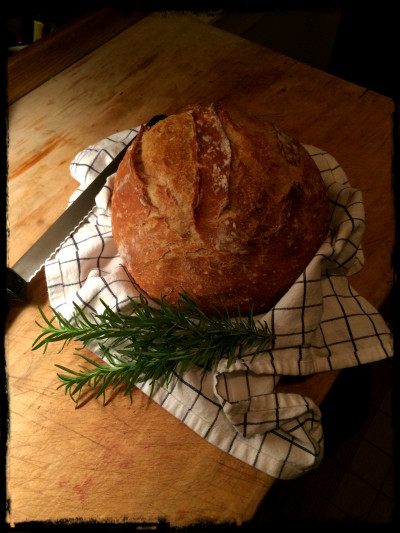Simple Ingredients

“Bread for You.”
“A loaf of bread,” the Walrus said, “is what we chiefly need: Pepper and vinegar besides are very good indeed.” Lewis Carroll
The mornings are brisk now in mid-October, and on the days when the sky is massed with clouds, it seems particularly chilly-willy here at the computer, my hands covered in David Copperfield gloves, cold fingers moving slowly over the white keyboard.
Autumn, for all its beauty, is a wistful time, as the sun sinks ever lower, leaves fall, summer takes its place in memory. But it is the cold, seeping through the cracks and old windows of this house, that makes me skittery, unable to focus. It is the cold that inches toward the heart.
I look to the furnace, the faltering sun, layers of cotton and wool for comfort, forgetting that warmth can also come from unexpected places. When the knock on the door came, I was working on a poem, and it was a slow-go, words coming, as my grandmother used to say, “Like molasses in January.”
When I opened the door, a friend stood there with a paper grocery bag in his hands. “Here,” he said. “Bread for you.” In the brown bag was a large, still warm, golden round of bread: fragrant, crusty, delectable. My friend told me about the process of measuring, stirring, kneading, and waiting for simple ingredients: flour, water, a bit of sugar, and yeast to transform into the miracle of bread. He talked about going by the feel of it now, knowing the process so instinctively by touch after much practice. He added, “It’s a mess, at first.”
That last line resounded like a clatter in an empty hallway. I know that the beginning of the creative process is pretty much a mess: paint, paper, spatters, threads, flour, clay, stone, scraps, paste clutter the worktable, but even more, emotionally: blank pages, empty canvases, solid black screens give rise to trepidation, and questions float to the surface like dead leaves: Will something come? Will it be good enough? Is there anything left for me to say?
Another friend, who is now making award-winning, experimental films that really push boundaries, said to me, “You just have to start somewhere. Jump in.” It can be bread, a poem, an aria, a book, a film, a painting, a dress, a sculpture, a garden, a trip to Venice. Doesn’t matter. We hesitate, pace round the periphery until the jump-in moment impels, and we have to work with whatever we get. Believe in it too.
Otherwise, the cold wins.